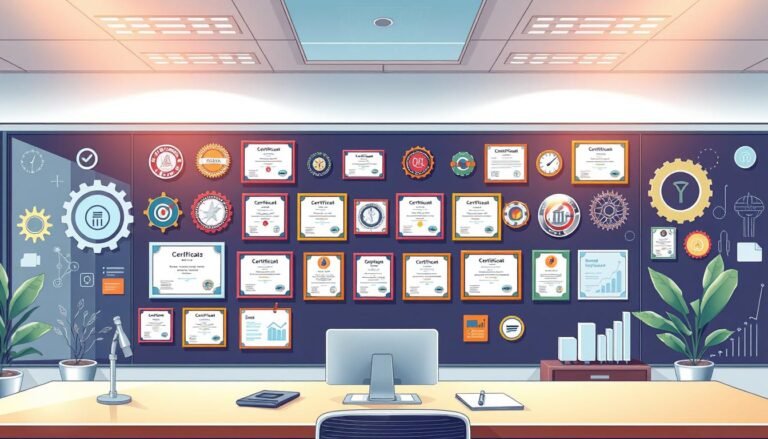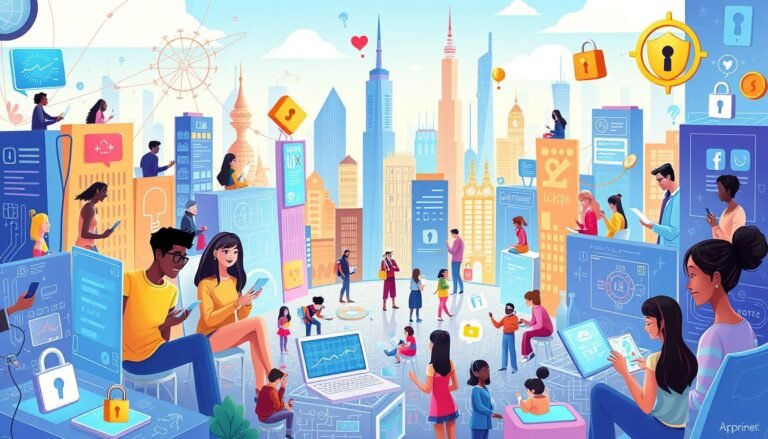Trends in EdTech: What’s Driving Education Innovation in 2025
Is the future of education really at our fingertips with technology, or are we just starting to see the beginning of a learning revolution?
As we look ahead to 2025, education is changing fast, thanks to new tech. This change aims to make learning more personal, engaging, and effective. It’s all about giving students better learning experiences, thanks to big investments in tech.
What’s driving this big leap in EdTech? It’s all about using AI for personalized learning and new tech like Virtual Reality (VR) and Augmented Reality (AR). Educators are ready to change how we teach and prepare students for a tech-filled future.
The Elementary and Secondary School Emergency Relief (ESSER) program gave schools $189.5 billion, but it ended in September. Now, schools are making smarter choices about the tech they buy. Vendors need to show how their products work well in this new era, making smart choices key.
Key Takeaways
- Educators are moving towards using AI to improve teaching and learning.
- Developing AI tools by educators is important to reflect real teaching challenges and improve teamwork.
- The end of the ESSER program means schools need to make tech choices based on solid data.
- AI literacy will be as important as basic digital skills, promoting ethical AI use.
- By 2027, 57 million people will use online learning, showing the need for flexible learning options.
- EdTech trends are moving towards personalized learning, inclusive education, and dynamic teaching methods.
- Cloud-based Learning Management Systems (LMS) are key for global access and teacher collaboration.
AI and Personalized Learning
In 2025, education will change a lot thanks to AI. AI-driven learning platforms will make learning fit each student’s needs. They will use adaptive learning tech to offer a rich learning experience.
AI-Driven Personalized Learning Platforms
AI-powered learning platforms are key to this change. They use machine learning and data to customize learning. This includes videos, quizzes, and exercises that fit each student’s learning style.
Students get feedback right away. This helps them focus and understand better.
- AI virtual tutors offer interactive teaching methods.
- Automated content creation tools assist in developing course materials.
- Predictive insights help identify and support struggling students.
Teacher Training and AI Literacy
Teachers need to know how to use AI in class. Training programs are essential. They teach teachers how to use AI tools effectively.
These programs include tutorials and videos. This helps teachers use AI to improve learning.
- North Carolina’s Catawba County Schools are adopting generative AI tools.
- 29% of institutions offer tutorials on using AI tools.
- 30% provide video training for educators and students.
Ethical Considerations of AI in Education
AI in education has big benefits, but we must think about ethics. We need to make sure AI is fair, transparent, and respects privacy. AI must be used wisely to avoid problems like biased algorithms and data security issues.
Guidelines for using generative AI are important. This balance between innovation and ethics is crucial. AI can make education more inclusive and effective. We should focus on the benefits for both teachers and students.
Immersive Learning Technologies
Immersive learning technologies like VR and AR are changing how we learn. They bring real-world experiences into classrooms. This helps students understand complex subjects better.
The COVID-19 pandemic made these technologies more popular. It started a new chapter in education technology.
Virtual Reality (VR) and Augmented Reality (AR)
VR and AR are making learning fun and interactive. At UC Berkeley, they’re exploring how these technologies can improve teaching and research. The market for educational AR and VR grew to $3.8 billion last year.
It’s expected to hit $14.2 billion by 2028. These tools offer new ways to learn, but there are concerns about cost and privacy.
3D Printing in Classrooms
3D printing helps students learn by doing. It lets them create and test their ideas in real life. This hands-on approach boosts creativity and understanding.
It makes learning more tangible and practical. Students can see their ideas come to life.
Robotics and STEAM Education
Robotics are key in moving from STEM to STEAM education. STEAM adds the arts to teach creative problem-solving. This mix makes learning more holistic.
More people are searching for robotics and STEAM education. This shows growing interest in these fields.
| Immersive Technology | Statistics |
|---|---|
| EdTech relevance for 2023 | 19% of respondents in an EdTech Twitter poll consider it most relevant |
| Educational AR and VR market | Reached $3.8 billion last year; forecasted to reach $14.2 billion by 2028 |
| Searches for “CodeMonkey” | Increased by 200% in 5 years |
| Searches for “Interplay Learning” | Increased by 343% in 5 years |
Online Learning Platforms and Remote Teaching Tools
Online learning platforms and mobile apps are changing how we learn. Now, you can learn on any device, anytime, anywhere. Digital tools like interactive software and cloud-based platforms are making learning more personal and fun.
Growth of Mobile Learning Applications
Mobile learning apps are becoming more popular. They make learning easy and convenient. Apps like Kahoot! and Google Classroom make learning interactive and fun.
- Kahoot!: A game-based learning platform that makes education fun through interactive quizzes, fostering a competitive and engaging learning environment.
- Google Classroom: A cloud-based platform facilitating communication, collaboration, and content management between teachers and students.
AI-Powered Career Guidance and Self-Paced Learning
AI is helping in education beyond the classroom. It offers personalized learning paths and career advice. Platforms like DreamBox and Knewton adjust content based on student performance, meeting individual needs.
- DreamBox: Uses adaptive learning technology to provide real-time tailored instruction based on student performance.
- Knewton: Adjusts educational content in real-time, offering personalized learning experiences.
Data-Driven Decision Making and Analytics
Data analytics in education helps improve student outcomes. Learning analytics tools give insights into student performance and engagement. This helps make education more effective.
| Tool | Purpose | Impact |
|---|---|---|
| Zoom | Facilitate remote learning and collaboration | Supports virtual classrooms and real-time communication |
| Microsoft Teams | Enable group projects and digital document sharing | Enhances collaboration and remote education |
| Google Classroom | Content management and teacher-student communication | Streamlines educational processes and improves accessibility |
EdTech tools like Zoom, Microsoft Teams, and Google Classroom help with collaboration and communication. They make learning more efficient, engaging, and accessible.
Trends in EdTech: What’s Driving Education Innovation
Education is changing fast, thanks to new EdTech trends. Artificial intelligence (AI) is coming to schools in 2024. It will help teachers by doing routine tasks, so they can focus on helping students.
Virtual and augmented reality are making learning fun. They’re great for science and history. Students get to do cool experiments and explore history in a new way.
In 2024, schools will offer more choices. Families want learning that fits their kids’ needs. This is thanks to new funding and a push for personalized learning.
Learning is becoming more real-world. Schools are mixing subjects together in projects. This helps students get ready for life after school.
| Trend | Description | Impact |
|---|---|---|
| AI Integration | Automates tasks, enhances creative processes, and supports teachers in coaching roles | Increases student engagement, reduces administrative burdens for teachers |
| VR and AR Technologies | Provides immersive learning environments for science and history | Enhances student understanding and interest in educational material |
| School Choice and ESAs | Offers personalized and diverse educational options | Empowers families to select tailored learning experiences |
| Advanced LMS | Focuses on student and guardian experiences, driven by ESSER funding | Improves online learning platforms, meeting the needs of students and parents |
| Project-Based Learning | Encourages cross-disciplinary approaches and real-world applications | Prepares students for future challenges, integrating multiple subjects |
There’s a lot of money and new ideas in education. This is especially true for K-12 and workforce education. These changes will make learning better and more fun for everyone.
Conclusion
Looking ahead, EdTech for 2025 promises big changes in education. Artificial Intelligence, immersive learning, and online platforms will make learning better and more accessible worldwide. Already, AI in Learning Management Systems is growing fast, with 86% of teachers seeing its value in schools.
Virtual Reality and Augmented Reality are changing how we learn. Companies like Labster and Google Expeditions are leading this change. They make learning fun and interactive, improving understanding in many subjects.
The demand for game-based learning is also rising. It’s expected to reach USD 29.7 billion by 2026. This shows how much people want learning tools that are fun and engaging.
Online learning platforms are also key. Khan Academy and Coursera have made quality education more accessible. With more people having internet, these platforms will help even more people learn.
The EdTech market is growing fast, from $227 billion in 2020 to $404 billion by 2025. This growth shows how important technology is in education today and tomorrow.
In short, EdTech is changing education for the better. It offers new ways to learn, like personalized platforms and immersive experiences. As technology advances, education will keep getting better, preparing students for the future.
Source Links
- What to Expect for Ed Tech in 2025: Experts Weigh In
- Top Education Technology Trends to Watch in 2025
- AI Trends That Will Transform EdTech in 2025
- AI in EdTech: Rethinking the Speed of Innovation
- Innovation Unleashed: The Pivotal EdTech Trends Reshaping Education in 2024
- Immersive Learning’s Future in Higher Education
- The 9 Most Interesting EdTech Trends Of 2024
- Education Technology
- 6 trends that are driving change and innovation in K12
- Edtech Trends Archives
- Drivers of Innovation in Education : Comparing Workforce, Higher Education, and K12
- Future of Education Technology in 2024: Trends in Ed-Tech and Opinions of Industry’s Most Thought Leaders
- The trends and innovations in the edtech industry and their implications for society








